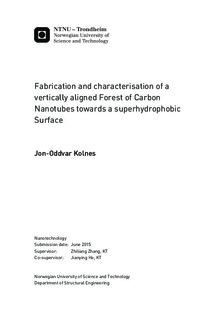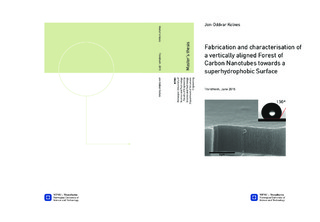| dc.description.abstract | Owing to their unique water repellent properties, superhydrophobic surfaces offer a vast number of potential industrial applications. From self-cleaning windows to more efficient microfluidic devices, research on what makes a surface repel water has led to several energy-saving solutions.
This thesis investigates the possibility that a surface of vertically aligned carbon nanotubes (CNTs) can be made superhydrophobic by functionalisation with perfluorododecyltrichlorosilane (FDTS). The characteristics that govern wetting behaviour and makes a surface water repellent are reviewed, with particular focus on the importance of contact angles and the water adhesion force. The unique properties of carbon nanotubes are presented, and methods for growth and fabrication of CNT surfaces are summarised.
By the use of plasma enhanced chemical vapour deposition (PECVD), a carbon nanotube surface is grown on a silicon substrate. A barrier layer of aluminium oxide separates the substrate from the iron catalyst on which carbon growth is initiated. The surface is examined by the use of scanning electron microscopy (SEM) and transmission electron microscopy (TEM), revealing the grown CNTs to be multi-walled CNTs (MWCNTs), with lengths of 5µm and tube widths ranging from 8nm to 50nm. To achieve superhydrophobicity, the structure is treated by oxygen plasma and a solution of FDTS that lowers the surface energy. Contact angles are measured, and recorded to be as high as 130°. By using a tensiometer, water adhesion forces
were measured, with the lowest observed value value being 279.3µN.
Those are typical characteristics of a hydrophobic surface. Although not superhydrophobic, both surface structure and functionalisation show an impressive improvement compared to the original unstructured substrate. | |

